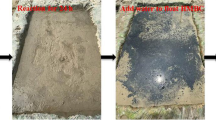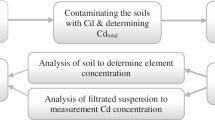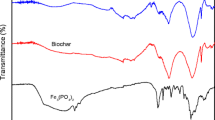Abstract
Cadmium (Cd) re-mobilize by phosphate-solubilizing bacteria (PSB) from immobilization contaminated soil has drawn great attention due to its serious threat to human health through food chain. However, Cd binding with weathered coal (WC), an effective Cd immobilization material, will be re-mobilized by PSB or not is still unclear. In this study, the soil and sand pots with Cd were respectively mixed with the weight fractions of 0‰, 2‰, and 3‰ WC, inoculated with or without PSB, and planted with Amaranthus mangostanus L. The experimental results indicated that: (i) Cd in soil was transformed into organic fraction with WC, which has been led to the Cd accumulation concentrations in roots and shoots reduced by 38.8% and 20.5%, respectively; (ii) PSB could promote the concentration of exchangeable-Cd fraction and soil Cd uptake by amaranth in all treatments; and (iii) WC application in sand pot respectively reduced the Cd accumulation by 47.5% in roots and 24.1% in shoots, but PSB inoculation showed no significant effect on Cd accumulation in plants under WC application. SEM, zeta potential, and FT-IR results showed that PSB inoculation after Cd immobilized by WC had no influence on the microstructure, amount of negative charge, type, and content of functional groups in WC, indicating that organic fraction Cd in WC was not re-mobilized by PSB. Therefore, the application of WC in contaminated soil was conducive to transforming Cd in organic-bound forms and intensifying Cd immobilization effects.





Similar content being viewed by others
References
Ahmad M, Rajapaksha AU, Lim JE, Zhang M, Bolan N, Mohan D, Vithanage M, Lee SS, Ok YS (2014) Biochar as a sorbent for contaminant management in soil and water: a review. Chemosphere 99:19–33
Alroudhan A, Vinogradov J, Jackson MD (2016) Zeta potential of intact natural limestone: impact of potential-determining ions Ca, Mg and SO4. Colloids Surf A Physicochem Eng Asp 493:83–98
Arivalagan P, Singaraj D, Haridass V, Kaliannan T (2014) Removal of cadmium from aqueous solution by batch studies using Bacillus cereus. Ecol Eng 71:728–735
Bai HC, Jiang ZM, He MJ, Ye BY, Wei SQ (2018) Relating Cd2+ binding by humic acids to molecular weight: A modeling and spectroscopic study. J Environ Sci 70:154–165
Caporale AG, Pigna M, Sommella A, Conte P (2014) Effect of pruning-derived biochar on heavy metals removal and water dynamics. Biol Fertil Soils 50:1211–1222
Gao JL, Liu QL, Song LZ, Shi BY (2019) Risk assessment of heavy metals in pipe scales and loose deposits formed in drinking water distribution systems. Sci Total Environ 652:1387–1395
Ge N, Xu JJ, Peng BZ, Pan SY (2017) Adsorption mechanism of tenuazonic acid using inactivated lactic acid bacteria. Food Control 82:274–282
Guo SH, Hu N, Li QS, Yang P, Wang LL, Xu ZM, Chen HJ, He BY, Zeng EY (2018) Response of edible amaranth cultivar to salt stress led to Cd mobilization in rhizosphere soil: a metabolomic analysis. Environ Pollut 241:422–431
He HD, Ye ZH, Yang DJ, Yan JL, Xiao L, Zhong T, Yuan M, Cai XD, Fang ZQ, Jing YX (2013) Characterization of endophytic Rahnella sp. JN6 from Polygonum pubescens and its potential in promoting growth and Cd, Pb, Zn uptake by Brassica napus. Chemosphere 90:1960–1965
He BY, Yu DP, Chen Y, Shi JL, Xia Y, Li QS, Wang LL, Ling L, Zeng EY (2017) Use of low-calcium cultivars to reduce cadmium uptake and accumulation in edible amaranth (Amaranthus mangostanus L.). Chemosphere 171:588–594
Jiang CY, Sheng XF, Qian M, Wang QY (2008) Isolation and characterization of a heavy metal-resistant Burkholderia sp. from heavy metal-contaminated paddy field soil and its potential in promoting plant growth and heavy metal accumulation in metal-polluted soil. Chemosphere 72:157–164
Li K, Ramakrishna W (2011) Effect of multiple metal resistant bacteria from contaminated lake sediments on metal accumulation and plant growth. J Hazard Mater 189:531–539
Li L, Yan M, Zhang Q (2009) Effects of weathered coal to the availableness state of heavy metals cadmium and plumbum in the alkaline soil. J Shanxi Agric Sci 37:32–35 (in Chinese)
Li H, Liu Y, Zhou YY, Zhang JC, Mao QM, Yang Y, Huang HL, Liu ZH, Peng QH, Luo L (2018a) Effects of red mud based passivator on the transformation of Cd fraction in acidic Cd-polluted paddy soil and Cd absorption in rice. Sci Total Environ 640:736–745
Li JY, Zheng BH, He YZ, Zhou YY, Chen X, Ruan S, Yang Y, Dai CH, Tang L (2018b) Antimony contamination, consequences and removal techniques: a review. Ecotoxicol Environ Saf 156:125–134
Liang XF, Han J, Xu YM, Sun YB, Wang L, Tan X (2014) In situ field-scale remediation of Cd polluted paddy soil using sepiolite and palygorskite. Geoderma 235:9–18
Maji D, Misra P, Singh S, Kalra A (2017) Humic acid rich vermicompost promotes plant growth by improving microbial community structure of soil as well as root nodulation and mycorrhizal colonization in the roots of Pisum sativum. Appl Soil Ecol 110:97–108
Mei XQ, Li SS, Li QS, Yang YF, Luo X, He BY, Li H, Xu ZM (2014) Sodium chloride salinity reduces Cd uptake by edible amaranth (Amaranthus mangostanus L.) via competition for Ca channels. Ecotoxicol Environ Saf 105:59–64
Ontiveros-Ortega A, Vidal F, Gimenez E, Ibáñez JM (2014) Effect of heavy metals on the surface free energy and zeta potential of volcanic glass: implications on the adhesion and growth of microorganisms. J Mater Sci 49:3550–3559
Pei GP, Li YX, Zhu YE, Shi WY, Li H (2017) Immobilization of lead by application of soil amendment produced from vinegar residue, stainless steel slag, and weathered coal. Environ Sci Pollut Res 24:22301–22311
Rezakhani L, Motesharezadeh B, Tehrani MM, Etesami H, Hosseini HM (2019) Phosphate–solubilizing bacteria and silicon synergistically augment phosphorus (P) uptake by wheat (Triticum aestivum L.) plant fertilized with soluble or insoluble P source. Ecotoxicol Environ Saf 173:504–513
Rubio PS, Godoy MS, Della Mónica IF, Pettinari MJ, Godeas AM, Scervino JM (2016) Carbon and nitrogen sources influence tricalcium phosphate solubilization and extracellular phosphatase activity by Talaromyces flavus. Curr Microbiol 72:41–47
Teng ZD, Shao W, Zhang KY, Huo YQ, Li M (2019) Characterization of phosphate solubilizing bacteria isolated from heavy metal contaminated soils and their potential for lead immobilization. J Environ Manag 231:189–197
Tessier A, Campbell PG, Bisson M (1979) Sequential extraction procedure for the speciation of particulate trace metals. Anal Chem 51:844–851
Ullah A, Heng S, Munis MFH, Fahad S, Yang XY (2015) Phytoremediation of heavy metals assisted by plant growth promoting (PGP) bacteria: a review. Environ Exp Bot 117:28–40
Wang B, Tan JX, Dai JY (2007) Effect of humic acid on ionic form distribution and activity of lead and cadmium in pond sediment. Chinese J Soil Sci 38:106–110 (in Chinese)
Wang F, Lu XW, Li XY (2016) Selective removals of heavy metals (Pb2+, Cu2+, and Cd2+) from wastewater by gelation with alginate for effective metal recovery. J Hazard Mater 308:75–83
Wang XH, Luo WW, Wang Q, He LY, Sheng XF (2018) Metal (loid)-resistant bacteria reduce wheat Cd and As uptake in metal (loid)-contaminated soil. Environ Pollut 241:529–539
Wang Y, Li YM, Zhang Y, Wei W (2019) Effects of macromolecular humic/fulvic acid on Cd (II) adsorption onto reed-derived biochar as compared with tannic acid. Int J Biol Macromol 134:43–55
Yang P, Zhou XF, Wang LL, Li QS, Zhou T, Chen YK, Zhao ZY, He BY (2018) Effect of phosphate-solubilizing bacteria on the mobility of insoluble cadmium and metabolic analysis. Int J Environ Res Public Health 15:1330–1342
Yu Y, Wan YN, Wang Q, Li HF (2017) Effect of humic acid-based amendments with foliar application of Zn and Se on Cd accumulation in tobacco. Ecotoxicol Environ Saf 138:286–291
Yu H, Cui J, Qiao J, Liu C, Li F (2018a) Principle and technique of arsenic and cadmium pollution control in paddy field. J Agro-Environ Sci 37:1418–1426 (in Chinese)
Yu Y, Wan YN, Camara AY, Li HF (2018b) Effects of the addition and aging of humic acid-based amendments on the solubility of Cd in soil solution and its accumulation in rice. Chemosphere 196:303–310
Yu LY, Huang HB, Wang XH, Li S, Feng NX, Zhao HM, Huang XP, Li YW, Li H, Cai QY, Mo CH (2019) Novel phosphate-solubilising bacteria isolated from sewage sludge and the mechanism of phosphate solubilisation. Sci Total Environ 658:474–484
Zhang LJ, Tan XH, Han J, Wang BJ, Liu DH (2009) Remediation effects of different additives on the soil contaminated by heavy metals. Chinese J Soil Sci 40:1176–1180 (in Chinese)
Zhang SQ, Yuan L, Li W, Lin ZA, Li YT, Hu SW, Zhao BQ (2017) Characterization of pH-fractionated humic acids derived from Chinese weathered coal. Chemosphere 166:334–342
Zhou GY, Jiang HM, Yang JC, Zhang JF, Zhang SQ, Liang L (2016) Effects of different organic materials on bio-availability of Cd, Pb in a contaminated greenhouse soil. Environ Sci 37:4011–4019 (in Chinese)
Zhu J, Li M, Whelan M (2018) Phosphorus activators contribute to legacy phosphorus availability in agricultural soils: a review. Sci Total Environ 612:522–537
Funding
This work was supported by the National Natural Science Foundation of China [grant numbers 41673094]; the Department of Science and Technology of Guangdong Province, China [grant number 2017A010105005]; and the National Key Research Project of China [grant number 2017YFD0801305].
Author information
Authors and Affiliations
Corresponding author
Additional information
Responsible editor: Diane Purchase
Publisher’s note
Springer Nature remains neutral with regard to jurisdictional claims in published maps and institutional affiliations.
Highlights
Binding of soil Cd with weathered coal can effectively inhibit Cd uptake by crops.
Phosphate-solubilizing bacteria (PSB) can mobilize Cd in carbonate/Fe-Mn oxide forms.
Re-mobilization of Cd from weathered coal by PSB was not observed in sand pot trail.
Electronic supplementary material
ESM 1
(DOCX 26 kb)
Rights and permissions
About this article
Cite this article
Gao, Q., Li, QS., He, BY. et al. Phosphate-solubilizing bacteria will not significantly remobilize soil cadmium remediated by weathered coal. Environ Sci Pollut Res 26, 29003–29011 (2019). https://doi.org/10.1007/s11356-019-06142-6
Received:
Accepted:
Published:
Issue Date:
DOI: https://doi.org/10.1007/s11356-019-06142-6




